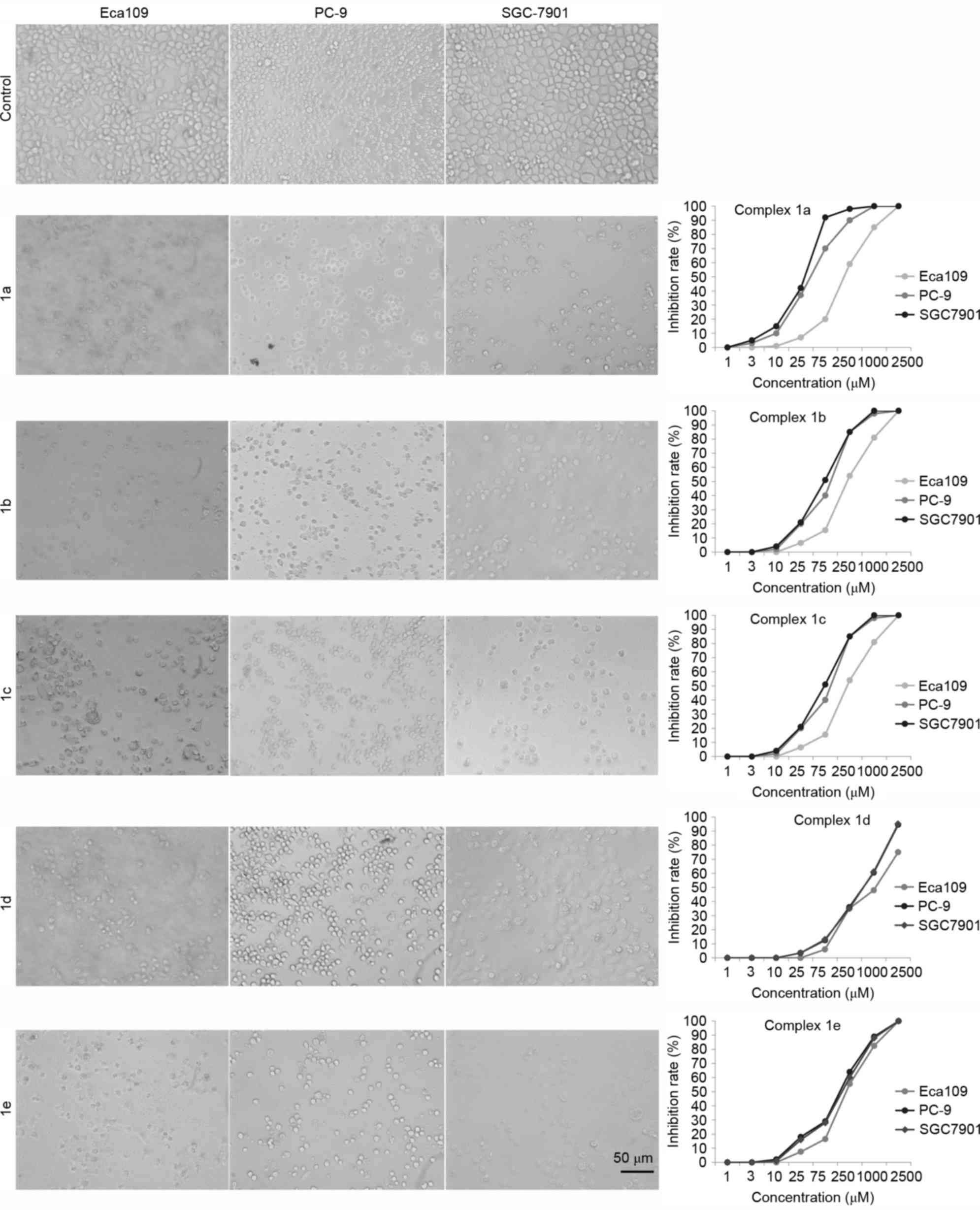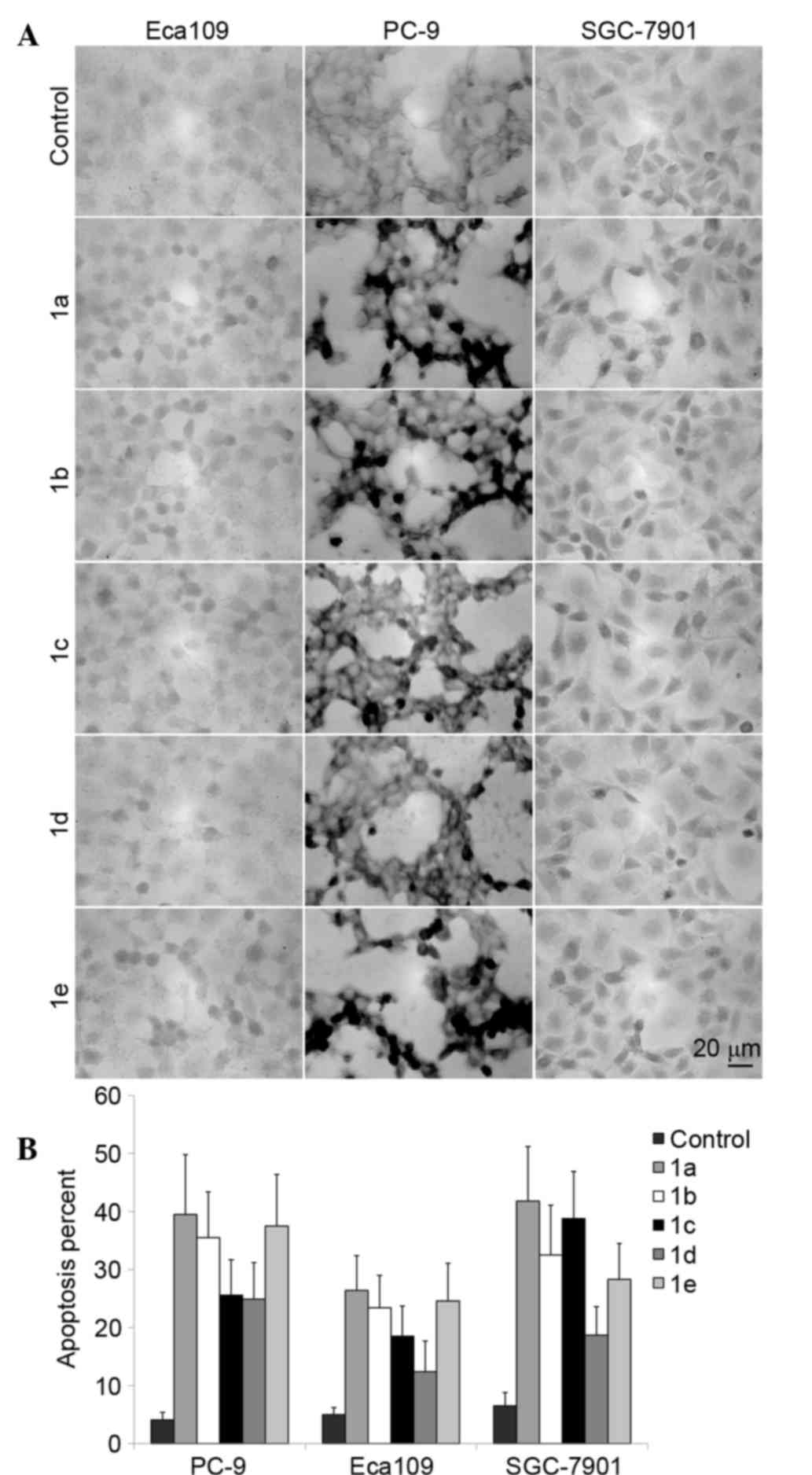|
1
|
Huang H, Chen Q, Ku X, Meng L, Lin L, Wang
X, Zhu C, Wang Y, Chen Z, Li M, et al: A series of
alpha-heterocyclic carboxaldehyde thiosemicarbazones inhibit
topoisomerase IIalpha catalytic activity. J Med Chem. 53:3048–3064.
2010. View Article : Google Scholar : PubMed/NCBI
|
|
2
|
Jansson PJ, Sharpe PC, Bernhardt PV and
Richardson DR: Novel thiosemicarbazones of the ApT and DpT series
and their copper complexes: Identification of pronounced redox
activity and characterization of their antitumor activity. J Med
Chem. 53:5759–5769. 2010. View Article : Google Scholar : PubMed/NCBI
|
|
3
|
Soares MA, Lessa JA, Mendes IC, Da Silva
JG, Dos Santos RG, Salum LB, Daghestani H, Andricopulo AD, Day BW,
Vogt A, et al: N(4)-Phenyl-substituted 2-acetylpyridine
thiosemicarbazones: Cytotoxicity against human tumor cells,
structure-activity relationship studies and investigation on the
mechanism of action. Bioorg Med Chem. 20:3396–3409. 2012.
View Article : Google Scholar : PubMed/NCBI
|
|
4
|
Enyedy ÉA, Primik MF, Kowol CR, Arion VB,
Kiss T and Keppler BK: Interaction of Triapine and related
thiosemicarbazones with iron (III)/(II) and gallium (III): A
comparative solution equilibrium study. Dalton Trans. 40:5895–5905.
2011. View Article : Google Scholar : PubMed/NCBI
|
|
5
|
Kowol CR, Trondl R, Arion VB, Jakupec MA,
Lichtscheidl I and Keppler BK: Fluorescence properties and cellular
distribution of the investigational anticancer drug triapine
(3-aminopyridine-2-carboxaldehyde thiosemicarbazone) and its zinc
(II) complex. Dalton Trans. 39:704–706. 2010. View Article : Google Scholar : PubMed/NCBI
|
|
6
|
Zeglis BM, Divilov V and Lewis JS: Role of
metalation in the topoisomerase IIα inhibition and
antiproliferation activity of a series of
α-heterocyclic-N4-substituted thiosemicarbazones and their Cu (II)
complexes. J Med Chem. 54:2391–2398. 2011. View Article : Google Scholar : PubMed/NCBI
|
|
7
|
Ramachandran E, Thomas SP, Poornima P,
Kalaivani P, Prabhakaran R, Padma VV and Natarajan K: Evaluation of
DNA binding, antioxidant and cytotoxic activity of mononuclear Co
(III) complexes of 2-oxo-1,2-dihydrobenzo [h]
quinoline-3-carbaldehyde thiosemicarbazones. Eur J Med Chem.
50:405–415. 2012. View Article : Google Scholar : PubMed/NCBI
|
|
8
|
Raja DS, Paramaguru G, Bhuvanesh NS,
Reibenspies JH, Renganathan R and Natarajan K: Effect of terminal
N-substitution in 2-oxo-1,2-dihydroquinoline-3-carbaldehyde
thiosemicarbazones on the mode of coordination, structure,
interaction with protein, radical scavenging and cytotoxic activity
of copper (II) complexes. Dalton Trans. 40:4548–4559. 2011.
View Article : Google Scholar : PubMed/NCBI
|
|
9
|
Li MX, Zhang LZ, Yang M, Niu JY and Zhou
J: Synthesis, crystal structures, in vitro biological evaluation of
zinc (II) and bismuth (III) complexes of 2-acetylpyrazine
N(4)-phenylthiosemicarbazone. Bioorg Med Chem Lett. 22:2418–2423.
2012. View Article : Google Scholar : PubMed/NCBI
|
|
10
|
Li MX, Zhang LZ, Zhang D, Ji BS and Zhao
JW: Synthesis, crystal structures, and biological evaluation of
manganese (II) and nickel (II) complexes of
4-cyclohexyl-1-(1-(pyrazin-2-yl)ethylidene)thiosemicarbazide. Eur J
Med Chem. 46:4383–4390. 2011. View Article : Google Scholar : PubMed/NCBI
|
|
11
|
Li MX, Zhang D, Zhang LZ and Niu JY:
Synthesis, crystal structures, and biological activities of
2-thiophene N(4)-methylthiosemicarbazone and its unusual
hexanuclear silver(I) cluster. Inorg Chem Commun. 13:1268–1271.
2010. View Article : Google Scholar
|
|
12
|
Matesanz AI, Leitao I and Souza P:
Palladium (II) and platinum (II) bis (thiosemicarbazone) complexes
of the 2,6-diacetylpyridine series with high cytotoxic activity in
cisplatin resistant A2780cisR tumor cells and reduced toxicity. J
Inorg Biochem. 125:26–31. 2013. View Article : Google Scholar : PubMed/NCBI
|
|
13
|
Matesanz AI and Souza P: Unprecedented
Pt(II) complex of an asymmetric 2,6-diacetylpyridine
bis(4N-substituted thiosemicarbazone) ligand. Inorg Chem Commun.
27:5–8. 2013. View Article : Google Scholar
|
|
14
|
Palanimuthu D, Shinde SV, Somasundaram K
and Samuelson AG: In vitro and in vivo anticancer activity of
copper bis (thiosemicarbazone) complexes. J Med Chem. 56:722–734.
2013. View Article : Google Scholar : PubMed/NCBI
|
|
15
|
Ilies DC, Pahontu E, Shova S, Gulea A and
Rosu T: Synthesis, characterization and crystal structures of
nickel(II), palladium(II) and copper(II) complexes with
2-furaldehyde-4-phenylthiosemicarbazone. Polyhedron. 51:307–315.
2013. View Article : Google Scholar
|
|
16
|
Vine KL, Matesic L, Locke JM, Ranson M and
Skropeta D: Cytotoxic and anticancer activities of isatin and its
derivatives: A comprehensive review from 2000–2008. Anticancer
Agents Med Chem. 9:397–414. 2009. View Article : Google Scholar : PubMed/NCBI
|
|
17
|
Ye XP, Zhu TF, Wu WN, Ma TL, Zhang ZP,
Wang Y and Jia L: Syntheses, characterizations and biological
activities of two Cu(II) complexes with acylhydrazone ligand
bearing pyrrole unit. Inorg Chem Commun. 47:60–62. 2014. View Article : Google Scholar
|
|
18
|
Wang Y, Yang ZY and Chen ZN: Synthesis,
characterization and DNA-binding properties of four Zn (II)
complexes with bis (pyrrol-2-yl-methyleneamine) ligands. Bioorg Med
Chem Lett. 18:298–303. 2008. View Article : Google Scholar : PubMed/NCBI
|
|
19
|
Sheldrick GM: SADABS, program for
empirical absorption correction of area detector data. University
of Göttingen; Germany: 1996
|
|
20
|
Sheldrick GM: SHELX-97, program for
crystal structure solution and refinement. University of Göttingen;
Germany: 1997
|
|
21
|
Yang M, Lu YL, Li MX, Xu XW and Chen L:
Synthesis, crystal structures and biological evaluation of
2-benzoylpyridine N(4)-cyclohexylthiosemicarbazone and its
binuclear copper(II) complex. Inorg Chem Commun. 35:117–121. 2013.
View Article : Google Scholar
|
|
22
|
Nouri K and Yazdanparast R: Proliferation
inhibition, cell cycle arrest and apoptosis induced in HL-60 cells
by a natural diterpene ester from Daphne mucronata. Daru.
19:145–153. 2011.PubMed/NCBI
|
|
23
|
Farnebo M, Bykov VJ and Wiman KG: The p53
tumor suppressor: A master regulator of diverse cellular processes
and therapeutic target in cancer. Biochem Biophys Res Commun.
396:85–89. 2010. View Article : Google Scholar : PubMed/NCBI
|
|
24
|
Shu D, Qing Y, Tong Q, He Y, Xing Z, Zhao
Y, Li Y, Wei Y, Huang W and Wu X: Deltonin isolated from Dioscorea
zingiberensis inhibits cancer cell growth through inducing
mitochondrial apoptosis and suppressing Akt and mitogen activated
protein kinase signals. Biol Pharm Bull. 34:1231–1239. 2011.
View Article : Google Scholar : PubMed/NCBI
|
|
25
|
Cory S and Adams JM: The Bcl2 family:
Regulators of the cellular life-or-death switch. Nat Rev Cancer.
2:647–656. 2002. View
Article : Google Scholar : PubMed/NCBI
|
|
26
|
Nagaraj NS, Anilakumar KR and Singh OV:
Diallyl disulfide causes caspase-dependent apoptosis in human
cancer cells through a Bax-triggered mitochondrial pathway. J Nutr
Biochem. 21:405–412. 2010. View Article : Google Scholar : PubMed/NCBI
|
|
27
|
Han YH, Kim SZ, Kim SH and Park WH:
Pyrogallol inhibits the growth of lung cancer Calu-6 cells via
caspase-dependent apoptosis. Chem Biol Interact. 177:107–114. 2009.
View Article : Google Scholar : PubMed/NCBI
|














